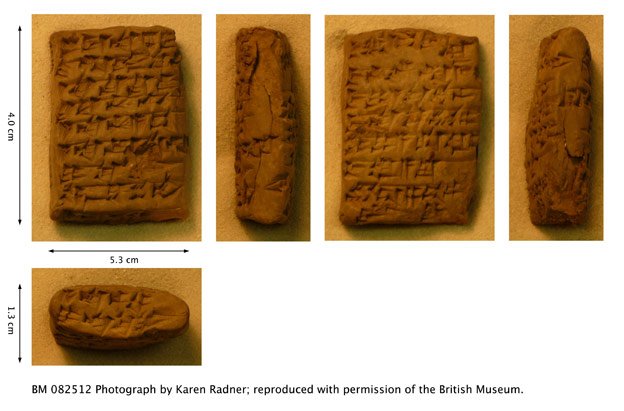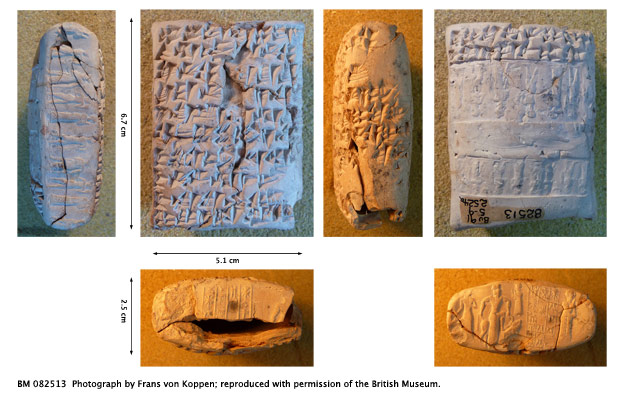BM 082512 and BM 082513: interest-free loan (inner tablet and envelope)

BM 082512: interest-free loan (inner tablet), from Sippar, reign of Sabium (Old Babylonian period, c.1780 BC). Photograph by Karen Radner; reproduced with permission of the British Museum. View large image.
This is the inner tablet of a loan contract which, when excavated at Sippar PGP , was enclosed in a clay envelope. The envelope bore a duplicate text of the inner tablet as well as the impressions of the cylinder seals of the debtor and three of the witnesses. It too is housed in the British Museum.

BM 082513: envelope of BM 082512. Photograph by Frans van Koppen; reproduced with permission of the British Museum. View large image.
The document records a charitable loan of silver, issued by the temple of the sun-god Šamaš PGP of Sippar PGP , the so-called Ebabbar. (For a Neo-Babylonian text from this temple's archives see BM 063926). The temple provides a man called Kišušu with the means to satisfy his creditor Ilum-abi, without charging any interest. Kišušu is to pay back the loan to the temple after he has brought in his harvest. This was the commonest time of year for paying off debts, as Mesopotamian landowners were usually solvent then.
The witnesses include high temple functionaries. The first one, Lipit-Ištar, impressed his father's seal on the upper edge of the envelope. Its inscription reads (with the cuneiform font switched to OB):
𒀭 𒌓 𒋰 𒉺 𒋗
𒀴 𒂍 𒌓𒌓
𒌉 𒀭 𒅗 𒀭 𒌓dUTU-tap-pa-šu
ARAD E2.BABBAR2
DUMU DINGIR-KA-dUTUŠamaš-tappašu,
servant of the Ebabbar (temple),
son of Annum-pi-Šamaš
The son had succeeded his father to the highest post in the temple of Šamaš, that of the šangûm, and using his seal highlighted the prestigious family connection. On the lower edge of the envelope, the second witness, Adad-remeni, used his own seal but its impression, including its inscription, was damaged when the tablet was opened. The scribe is a woman with the Sumerian name Nin-azu "The (divine) mistress is a healer", and she is likely to have been a devotee of the Šamaš temple, many of whom are known to have been literate. She is identified with the logogram 𒊩 𒁾 𒊬 fDUB.SAR for ṭupšarratum "female scribe" on the last line of the envelope; have a look for her title.
Note the space between the two seal impressions on the reverse of the envelope. At a first glance it appears to be empty. But a close look reveals remains of two lines of cuneiform script, originally giving the date (which is therefore only recorded on the inner tablet now). The scribe Ninazu erased these lines by smoothing over them with a wet finger. On a tablet inscribed with a smaller script the scribe would do this with the back of the stylus.
The reed stylus used to write this tablet was split, a sign of wear and tear which is most clearly visible in the vertical wedges; take a closer look. Ninazu would have written this one last tablet with her worn writing instrument but then certainly replaced it with a new stylus.
For a scale drawing of the text, view the record for this tablet on the British Museum's research database [http://www.britishmuseum.org/research/search_the_collection_database.aspx].
A transliteration and German translation of the text can be found in Schorr, Urkunden (1913), no. 52 (= CT 6, 40). Its envelope's seal impressions are published and discussed in Blocher, Siegelabrollungen (1992), no. XXI.
Content last modified on 10 Jan 2017.
Karen Radner
Karen Radner, 'BM 082512 and BM 082513: interest-free loan (inner tablet and envelope)', Knowledge and Power, Higher Education Academy, 2017 [http://oracc.museum.upenn.edu/saao/knpp/cuneiformrevealed/tabletgallery/bm082512andbm082513/]